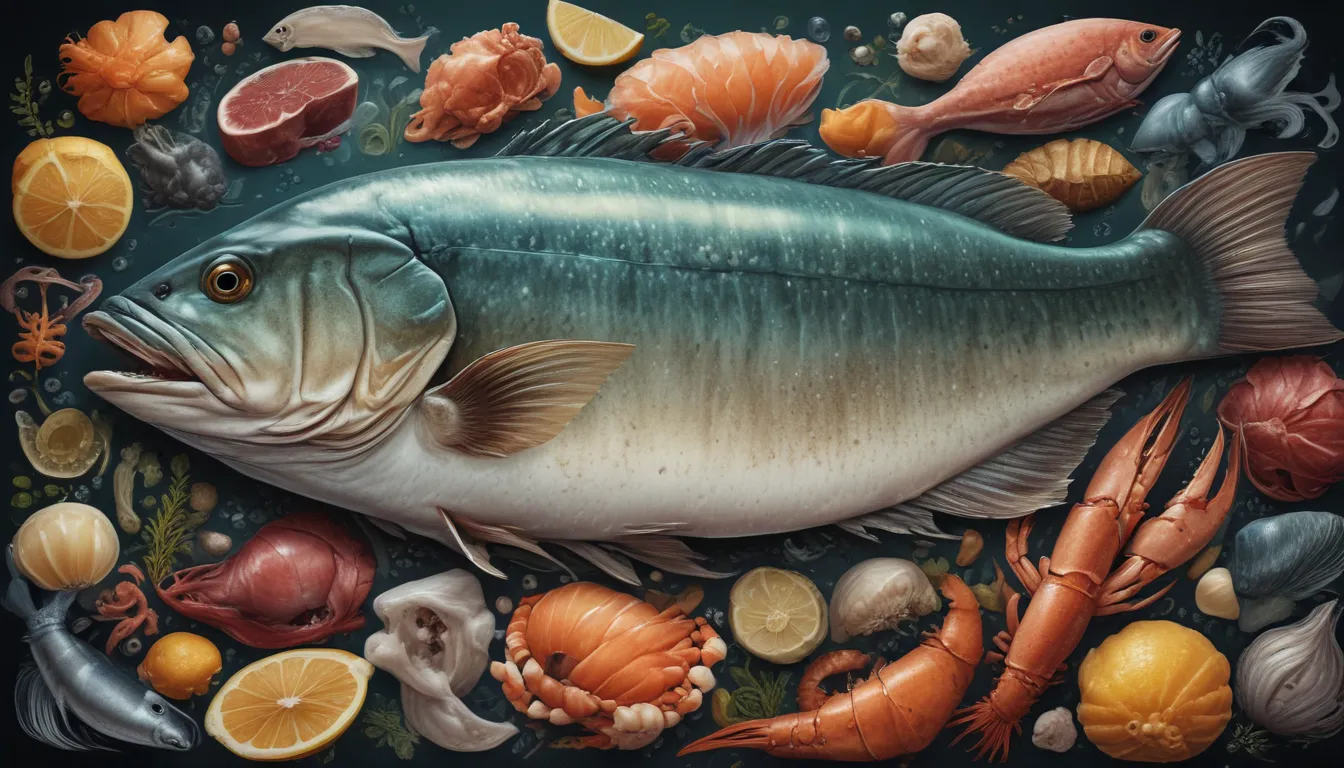The pictures in our articles might not always show exactly what the text is talking about. We use these images to make the article more interesting and eye-catching. They are there to add to the text, but not to replace it or show every detail.
Seafood is not just a delicious culinary choice; it's a treasure trove of health benefits and fascinating facts. From the rich source of omega-3 fatty acids to the surprising abilities of various sea creatures, the world of seafood is full of wonders waiting to be discovered. Whether you're a seafood enthusiast or simply curious about the ocean's bounty, join us on a journey to explore 20 intriguing facts about seafood that will expand your knowledge and tantalize your taste buds.
Unveiling the Health Benefits of Seafood
Seafood is a nutritional powerhouse, brimming with essential nutrients like omega-3 fatty acids, vitamins, and minerals. Its health benefits go beyond its mouthwatering flavors, making it a smart choice for a well-rounded diet. By incorporating seafood into your meals, you're not only treating yourself to a delightful experience but also nourishing your body with a wealth of nutrients that can boost your overall health and well-being.
The Global Love for Shrimp
Shrimp holds the title as the most consumed seafood worldwide, thanks to its succulent texture and versatile taste. Whether it's grilled, fried, or added to a savory seafood pasta, shrimp is a beloved delicacy in cuisines around the globe. Its popularity is a testament to its delicious flavor and culinary versatility, making it a go-to choice for seafood enthusiasts seeking a satisfying and delectable meal.
The Enigmatic Oyster: Master of Gender Change
Oysters are not only known for their aphrodisiac qualities but also for their remarkable ability to change gender. Influenced by environmental factors like temperature and food availability, oysters can transition from male to female and vice versa during their lifespan. This unique feature adds an intriguing layer to the mystique of these ocean-dwelling creatures, showcasing their adaptability and resilience in the marine environment.
Lobsters: Centenarians of the Sea
Lobsters are iconic symbols of longevity, with some individuals living for over 100 years. These majestic crustaceans outlive many modern inventions, showcasing their resilience and endurance throughout the decades. The next time you savor a buttery lobster tail, take a moment to appreciate the rich history and longevity of these fascinating sea creatures that have stood the test of time.
Demystifying Sushi: Beyond Raw Fish
Contrary to popular belief, sushi is not only about raw fish. This iconic Japanese dish encompasses vinegar-seasoned rice paired with a variety of toppings, including raw or cooked fish, vegetables, and eggs. The harmonious blend of flavors and textures in sushi offers a culinary experience that transcends the boundaries of traditional cuisine, inviting you to savor a tapestry of tastes and aromas in every bite.
The Blue Blood of Crabs
Ever wondered about the color of a crab’s blood? Unlike our crimson-hued blood, crab blood is blue due to the presence of copper in their circulatory system. This unique adaptation allows crabs to efficiently transport oxygen throughout their bodies, showcasing the marvels of nature's diverse biological mechanisms that set these marine creatures apart from terrestrial beings.
Nature’s Color-Changing Wonders: Fish and Their Adaptability
Certain fish, such as the clownfish, possess the remarkable ability to change their coloration to blend in with their surroundings or communicate with other individuals. This natural camouflage mechanism not only serves as a defense tactic against predators but also enhances their social interactions and courtship behaviors in the dynamic underwater world. Witnessing these color-changing displays is a testament to the beauty and adaptability of marine life.
The Triumphant Trio: Three Hearts of Octopuses
Octopuses are enigmatic creatures with three hearts, each serving a unique function in their circulatory system. Two of their hearts pump blood to their gills, while the third circulates oxygenated blood throughout their bodies. This biological marvel demonstrates the complexity and efficiency of octopuses' cardiovascular anatomy, allowing them to thrive in diverse marine environments and showcase their exceptional intelligence and adaptability.
Sardines: Sustainable Seafood Guardians
Sardines are not only a flavorful delight but also a sustainable seafood choice due to their abundance, rapid reproduction rate, and low environmental impact. By including sardines in your diet, you're making a conscientious decision that benefits both your health and the planet. Embrace the rich flavors and nutritional benefits of sardines while contributing to the preservation of marine ecosystems and sustainable seafood practices.
Seafood Splendor: A Nutrient-Rich Feast
Seafood is a treasure trove of essential vitamins and minerals vital for maintaining optimal health. From vitamin D and B12 to minerals like iodine and selenium, seafood offers a natural and delectable way to enhance your nutrient intake and support your overall well-being. Indulge in a feast of seafood delights while nourishing your body with a plethora of essential nutrients that promote vitality and longevity.
The Need for Speed: Tuna’s Swift Swimmers
Tuna are renowned for their remarkable speed and agility in the water, reaching speeds of up to 75 miles per hour. These powerful swimmers navigate the ocean with grace and efficiency, showcasing their innate ability to thrive in the vast marine expanse. Their impressive speed underscores their adaptability and prowess as one of the fastest fish in the ocean, making them a marvel to behold in their natural habitat.
Scallops: Eyes All Around
Scallops may appear delicate, but they harbor a fascinating feature – over 100 eyes that enable them to detect changes in light and movement. These simple yet effective visual organs help scallops navigate their environment, evade potential predators, and thrive in their underwater habitat. Their keen sense of sight underscores their adaptability and survival instincts, making them intriguing creatures in the realm of marine life.
Salmon’s Epic Journey: The Quest for Spawning
Salmon embark on an extraordinary journey to return to their birthplace for spawning, traveling thousands of miles across rivers and streams to complete their life cycle. This remarkable instinct highlights the resilience and determination of salmon as they overcome formidable obstacles to ensure the continuity of their species. Witnessing this epic migration is a testament to the natural wonders and innate instincts of these magnificent fish in the cycle of life and renewal.
Oyster’s Water Purification Magic
Oysters play a vital role in the health of marine ecosystems by filtering over 50 gallons of water per day, helping to purify their surroundings and maintain water quality. Their innate ability to cleanse the water by absorbing pollutants and particles showcases their ecological importance and contribution to balancing marine ecosystems. By appreciating the ecological services of oysters, we can foster a greater understanding of the interconnectedness of marine life and the importance of sustainable practices to preserve our ocean environments.
Shrimp’s Unique Anatomy: Hearts in Their Heads
Shrimp possess a fascinating anatomical feature with their hearts located in their heads, pumping blood to their brains and throughout their bodies. This unusual adaptation sets shrimp apart from other animals and underscores the diversity of marine life in its intricate biological design. By marveling at the unique anatomy of shrimp, we gain a deeper appreciation for the complexity and ingenuity of nature's creations in the underwater realm.
Squid’s Window to the Deep: Giant Eyes
Squid boast the largest eyes of any known living creature, providing them with exceptional vision in the deep, dark depths of the ocean. Their giant eyes serve as a vital tool for navigating their environment, detecting prey, and evading predators in the mysterious underwater world. The remarkable size and functionality of squid's eyes highlight their evolutionary adaptation to the challenging conditions of the deep sea, offering a glimpse into the wonders of marine life and the extraordinary capabilities of these fascinating cephalopods.
Crab’s Regenerative Prowess: Limb Regrowth
Crabs exhibit a remarkable ability to regenerate lost limbs through a process called autotomy, allowing them to grow new claws or legs in response to injury or predation. This adaptive mechanism enhances their survival chances in the face of adversity, showcasing their resilience and evolutionary advantage in the dynamic marine environment. Witnessing crabs' regenerative prowess is a testament to their remarkable ability to adapt and thrive in challenging conditions, underscoring the marvels of nature's resilience and innovation.
Mussels’ Natural Bonding: Creating Underwater Glue
Mussels possess a unique ability to secrete a powerful natural adhesive that allows them to adhere to rocks and other surfaces in the ocean. This natural bonding agent acts like underwater super glue, enabling mussels to create strong attachments and withstand the turbulent forces of the marine environment. By harnessing the power of natural glue, mussels showcase their adaptability and survival skills, highlighting the intricate mechanisms that enable marine organisms to thrive and flourish in their underwater habitats.
Electrifying Encounters: Fish with Electric Shocks
Electric eels and certain species of catfish possess the extraordinary ability to produce electric shocks for various purposes, including hunting prey and defending against predators. These electrifying capabilities showcase the diverse adaptations of marine life and its ingenious strategies for survival in the competitive underwater ecosystem. Witnessing the awe-inspiring feats of electric fish underscores the remarkable diversity and complexity of marine organisms, offering a glimpse into the fascinating world of underwater adaptations and behaviors.
A Feast for the Senses: Exploring Seafood Delights
From succulent shrimp to buttery lobster, flavorful salmon to crispy calamari, seafood offers a diverse and delightful culinary experience that captivates the senses. Whether you prefer your seafood grilled, baked, fried, or simmered in a savory stew, there's a culinary delight waiting for you to savor and enjoy. Indulge in a feast of seafood flavors and textures that tantalize your taste buds and ignite your passion for exquisite culinary experiences that celebrate the bounty of the ocean.
Embracing the Seafood Journey
In conclusion, the world of seafood is a captivating realm filled with wonders, from enchanting sea creatures to delectable culinary creations that delight the palate and nourish the body. By exploring the diverse aspects of seafood, you can gain a deeper appreciation for the ocean's bounty and the intrinsic connection between marine life and human well-being. Whether you're savoring a plate of fresh oysters, indulging in a mouthwatering shrimp cocktail, or relishing a succulent salmon fillet, seafood offers a culinary journey that enriches your senses and enhances your quality of life. Dive into the enchanting world of seafood and discover the myriad flavors, textures, and benefits that await you as you embark on a gastronomic adventure like no other.
Frequently Asked Questions
-
Is seafood healthy?
Yes, seafood is highly nutritious, offering a wealth of essential nutrients like high-quality protein, omega-3 fatty acids, vitamins, and minerals that support heart health, brain function, and overall well-being. -
How often should I eat seafood?
Health experts recommend consuming seafood at least twice a week as part of a balanced diet to ensure adequate intake of beneficial nutrients and promote optimal health. -
Are there any risks associated with seafood consumption?
While seafood is generally safe to eat, it's essential to choose fresh, properly cooked seafood to minimize the risk of foodborne illnesses. Certain individuals, such as pregnant women, young children, and those with weakened immune systems, should exercise caution with certain types of seafood that may contain contaminants like mercury. -
Can I enjoy seafood if I have allergies?
Some individuals may have allergies or sensitivities to seafood, necessitating identification and avoidance of problematic varieties. Consultation with a medical professional is advised for accurate diagnosis and guidance on managing seafood allergies effectively. -
What are some popular types of seafood?
An array of seafood options exists, including salmon, tuna, shrimp, lobster, crab, oysters, mussels, and squid, each offering distinctive flavors and textures that cater to a diverse range of culinary preferences and experiences.
Expand your culinary horizons and indulge in the wonders of seafood as you immerse yourself in a world of flavor, nutrition, and exploration. Whether you're a seafood aficionado or a curious newcomer, there's a wealth of knowledge and delight awaiting you as you embark on a voyage of discovery through the vast oceans of seafood wonders. Bon appétit!






